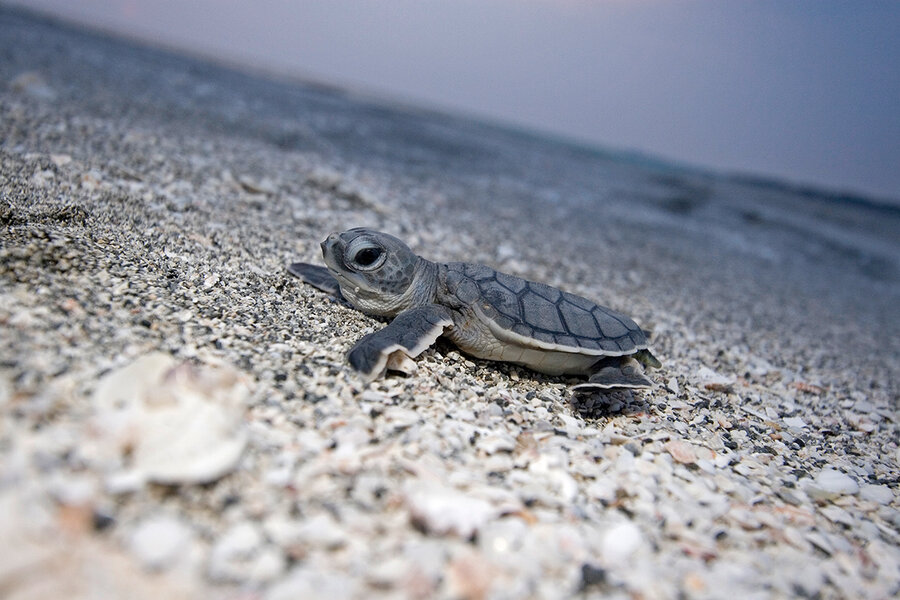Conservation success: Buoyed hopes for sea turtles
Loading...
Sea turtles are on the path to recovery, say scientists. But this is not a turtle story, this is a human story.
After half a century of conservation efforts, scientists are seeing long-term growth in some populations of the globe’s seven species of sea turtles, according to a paper published last month in the journal Science Advances.
“It's a success story,” says Gail Schofield, a postdoctoral researcher at Deakin University in Australia and coauthor on the study. Although not all populations of sea turtles are seeing the same boost, scientists say this is a sign that conservation efforts are on the right track. And shifts in human behavior and awareness about sea turtles have played key roles in this success.
Threats to sea turtles are largely human-related: habitat destruction, overharvesting females and eggs on nesting beaches, accidental bycatch, and increased predation of hatchlings and eggs by animals, like dogs and rats, introduced by humans.
Bans on commercial harvesting of sea turtles and innovations in fishing techniques have helped reduce adult mortality rates. But that success is tricky to track directly, as the foraging grounds where turtles spend much of their lives are widely dispersed throughout the globe's oceans and difficult for scientists to pin down.
So conservationists focus much of their attention on the turtles' nesting sites: beaches. And turtles are particularly vulnerable there, too.
Female sea turtles leave the ocean to lay their eggs, dragging their massive bodies slowly up the sand. Once a mother sea turtle has dug a hole, laid her eggs in it, and concealed them in sand the best she can, she crawls back to the ocean. When baby sea turtles hatch weeks later, they are just a couple of inches long, and commence an awkward sprint toward the water on freshly formed flippers, hustling to avoid predators, guided by cues such as moonlight glinting off the water.
Some conservationists simply monitor the nests and educate local communities to minimize disorienting light pollution and obstacles for turtles' beach voyage, while others build enclosures to protect them from predators and beachgoers.
Once the baby turtles make it to the ocean, the females won't return to lay their own eggs for decades. Scientists estimate that various species take somewhere from 10 to perhaps even 50 years to reach reproductive age.
Scientists rely on nest counts to estimate sea turtle population sizes, an imperfect and challenging gauge for conservation success. But with decades of conservation efforts ongoing now, encouraging numbers are starting to come in.
Green turtles in Hawaii are an oft-cited success story in sea turtle conservation. From 1973 to 2012, nesting numbers have grown from approximately 200 to 2000 nests.
The enforcement of the Endangered Species Act helped facilitate the recovery there through protection of turtles at nesting beaches and foraging habitats. But a ban on commercial fishing of the green turtles probably played the biggest role in this rebound, says George Balazs, a biologist who has spent much of his career working with Hawaii’s green turtles.
In Florida, green sea turtles have also seen a dramatic increase in numbers. In 1989, just 267 nests were identified; By 2015, that number had increased more than 100-fold to 27,975 nests. And public education and awareness has played a key role in that shift.
Mote Marine Laboratory and Aquarium in Sarasota, Fla., for example, does outreach with local hotels and condos so that visitors and residents alike can learn how to avoid disrupting nesting areas. An army of a couple hundred community volunteers also walk the beaches, marking off turtle crawls, the trails left behind when a mother turtle drags herself onto the beach to nest.
People stop and ask these patrols questions about the turtles and how best to coexist with them, says Kristen Mazzarella, senior biologist at Mote Marine Laboratory & Aquarium in Sarasota, Fla. "I think it's definitely opening people's eyes that turtles actually share the beaches here."
Despite regional successes, not all the populations analyzed in the study saw a long-term increase. Most showed no change, and leatherback turtles in the Pacific ocean are still declining.
“We need better data,” says North Carolina Sea Turtle Project biologist Matthew Godfrey, perhaps in the form of tracking technology, although it is prohibitively expensive. Nest counts are helpful, he says, but they only account for reproductive females; A direct index of population size would provide a more complete picture.
Scientists suspect that climate change could alter the sex ratios of populations, as warmer sand temperatures yield a higher number of female hatchlings than male. More holistic monitoring could help scientists better understand this effect, agrees Deakin University’s Dr. Schofield. That will take a globally coordinated effort, she says, as sea turtles' foraging grounds cross international borders.
“The conservation to this point has been phenomenal but we have to just keep going,” Schofield says.
Hannah Schlomann contributed to this report.









